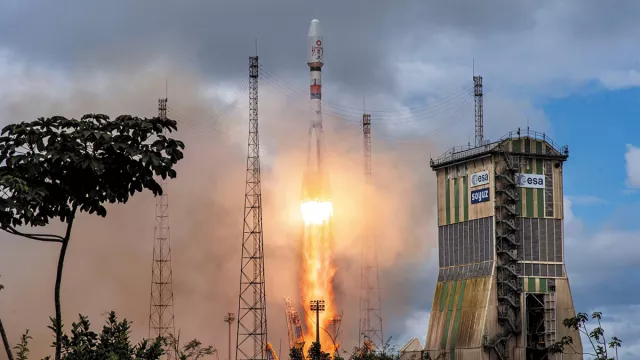Within the framework of an intergovernmental agreement, the Guiana Space Centre had been accommodating launches of Russia’s Soyuz vehicle since 2011.
Key information
| Mission | Space launch |
|---|---|
| Domain | Space transportation |
| Launch date | First launch 21 October 2011 |
| Partners | ESA, Roscosmos, Arianespace |
| Where | Guiana Space Centre (CSG) |
| Lifetime | 7 years |
| Status | Completed |
Key figures
- 308 tonnes: mass of Soyuz ST (Special Tropics) launcher
- 3.2 tonnes maximum payload mass to geostationary orbit
- 4.8 maximum payload mass to low Earth orbit
- 27 launches from October 2011 to March 2022
Key milestones
- 10 February 2022: Last Soyuz ST-B launch from CSG carrying 34 OneWeb satellites
- 29 December 2020: Last Soyuz ST-A launch from CSG carrying CSO-2 satellite
- 17 December 2011: First Soyuz ST-A launch from CSG carrying Pleiades 1A, Elisa and SSOT
- 21 October 2011: First Soyuz ST-B launch from CSG carrying 2 Galileo IOV-1 satellites
- November 2003: France and Russia sign intergovernmental agreement
- May 2003: European ministers vote in favour of project
- September 2002: Start of conceptual design studies
- June 2002: ESA Council decides to open spaceport in French Guiana to Russia’s Soyuz launcher
- May 2002: Signature of memorandum of understanding between Arianespace, the Russian space agency (then Rosaviakosmos) and Starsem to operate Soyuz in French Guiana
- End 2001: First official project talks between France and Russia
- 1999: First French study concerning possibility of operating Soyuz at CSG
Project in brief
Sanctions imposed on Russia by European governments and recent announcements by Roscosmos, the Russian federal space agency, have significantly impacted space cooperation with this former partner.
Within the framework of an intergovernmental agreement, the Guiana Space Centre (CSG) had been accommodating launches of Russia’s Soyuz vehicle since 2011. With the imminent arrival on the market of the new Vega-C and Ariane 6 launchers, a rescheduling of European institutional launches is now envisioned. CNES expedited procedures to enable the quick, safe and orderly departure of Russian engineers and technicians from the launch base. Consequently, the Soyuz in Guiana programme is currently suspended.
21 October 2011, a Soyuz launcher roared off the pad on its first-ever flight from the CSG, carrying aloft two European Galileo satellites. This milestone event marked the culmination of a collaboration initiated in 2003 by the European Space Agency (ESA), Roscosmos and CNES, the initiator of the Soyuz in Guiana programme and owner of the CSG.
Standing 46 metres tall and with a mass of 308 tonnes, Soyuz ST (for Special Tropics) is capable of placing payloads of up to 3.2 tonnes into geostationary transfer orbit (GTO), taking maximum advantage of the ‘slingshot’ effect imparted as a result of the CSG’s near-equatorial position. Built in Russia, Soyuz ST was adapted to the weather conditions in French Guiana and to the base’s range safety regulations. It was commercially operated by European launch services provider Arianespace.
Between 2011 and 2018, 20 Soyuz launchers lifted off from the purpose-built launch complex constructed by CNES in the municipality of Sinnamary.
CNES’s role
CNES was the initiator of the Soyuz in Guiana programme and is the owner of the CSG.
Contacts
Head of Space Transportation Strategy
Philippe Pujès
E-mail: philippe.pujes at cnes.fr


